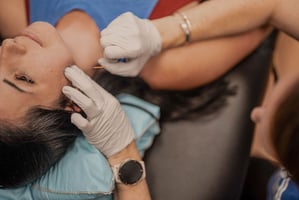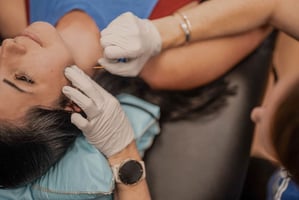Physical therapy offers a wide range of techniques aimed at reducing pain and improving physical...
Dry Needling for Runners: Preventing and Recovering from Injuries
Running is one of the most accessible and effective forms of exercise—but it also comes with a high risk of overuse injuries. Unlike contact sports where trauma is more common, runners often deal with repetitive strain issues caused by the same motion repeated thousands of times.
Every step places load on the joints, muscles, and connective tissue. When even a slight imbalance or weakness exists—whether in stride mechanics, core stability, or joint mobility—those small inefficiencies compound over time, leading to inflammation, tension, and eventual injury.
READ: Unlocking the Power of Dry Needling: Effective Pain Relief and Muscle Recovery in Wilmington, NC
.jpg?width=6016&height=4016&name=electrical-stimulation-in-physiotherapy-in-the-ph-2023-11-27-05-00-28-utc%20(2).jpg)
Common contributing factors include:
- Poor running mechanics
- Limited mobility in the hips or ankles
- Muscle imbalances or weaknesses
- Training errors (e.g., sudden increases in mileage or intensity)
- Lack of adequate recovery or cross-training
These issues make runners particularly vulnerable to conditions like IT band syndrome, shin splints, Achilles tendinopathy, and plantar fasciitis. That’s why many endurance athletes seek out therapies that not only address pain, but correct the underlying dysfunctions.
What Is Dry Needling and How Does It Help Runners?
Dry needling is a targeted technique used by physical therapists to relieve muscle tension, reduce pain, and improve movement. It involves inserting a thin, sterile needle into tight or overactive areas of muscle—often called trigger points—to stimulate a healing response and help the tissue relax.
For runners, this can be a game-changer.
Why It Works
Running demands smooth, coordinated muscle activation. When a muscle is tight, knotted, or overused, it doesn’t function efficiently—leading to poor mechanics and compensations that increase injury risk. Dry needling helps “reset” these problem areas by:
- Reducing excessive muscle tone
- Increasing blood flow to aid recovery
- Interrupting pain signals from trigger points
- Improving flexibility and mobility in restricted areas
Not Just for Injuries
Dry needling isn’t only reactive—it’s also preventive. By addressing tightness and dysfunction before it becomes painful, runners can maintain more balanced movement patterns and reduce their risk of injury during high-mileage training blocks.
At Paradigm Performance Therapy, dry needling is often combined with movement analysis and strength work to ensure each session leads to real, lasting results on the road or trail.
Common Running Injuries Treated with Dry Needling
Runners are especially vulnerable to soft tissue issues that stem from repetitive motion, overuse, and biomechanical inefficiencies. Dry needling can be an effective tool for treating many of these injuries by targeting the underlying muscle tension and movement restrictions contributing to pain.
Here are some of the most common running-related injuries that respond well to dry needling:
IT Band Syndrome
This condition causes pain on the outside of the knee and is often linked to tightness in the glutes, TFL, or hip stabilizers. Dry needling can release tension in these muscle groups, helping to reduce strain on the IT band and improve hip mechanics.
Plantar Fasciitis
Characterized by sharp heel or arch pain, plantar fasciitis often stems from tightness in the calf muscles or foot intrinsic muscles. Needling these areas can ease tissue tension and restore normal foot function.
Shin Splints (Medial Tibial Stress Syndrome)
Pain along the shin is usually related to tight or overworked tibialis anterior or posterior muscles. Dry needling can help calm inflammation and relieve pressure on the lower leg.
Hamstring or Calf Strains
Recurring tightness or minor strains in the hamstrings or calves are common in distance runners. Needling these trigger points can speed up healing and reduce re-injury risk by restoring tissue extensibility.
Piriformis Syndrome
This deep gluteal pain often involves pressure on the sciatic nerve from a tight piriformis muscle. Dry needling the piriformis and surrounding hip rotators can relieve compression and restore more natural hip movement.
In each of these cases, dry needling provides a quick and direct way to reduce muscle tension, promote healing, and restore mobility—making it a go-to tool in runner-specific recovery plans.
READ: Maximize Your Athletic Performance with Performance Physical Therapy in Wilmington, NC
How Dry Needling Enhances Recovery and Performance
Dry needling isn’t just about treating pain—it’s about unlocking better movement, faster recovery, and greater running efficiency. When used strategically, this technique can help runners not only heal from injuries, but return stronger and more resilient.
Speeds Up Muscle Recovery
Dry needling increases local blood flow and reduces muscle tension, helping the body flush out waste products and bring in nutrients that accelerate healing. This makes it a powerful recovery tool after hard training blocks, long runs, or races.
Improves Range of Motion
Tight or knotted muscles limit how well joints can move. By releasing those tight spots, dry needling helps restore normal range of motion—particularly in key areas for runners like the hips, calves, and hamstrings. Better mobility leads to more efficient, injury-resistant mechanics.
Enhances Running Form
When muscles are firing correctly and joints are moving freely, your stride becomes smoother and more effective. Dry needling can help restore balanced muscle function, allowing you to run with less compensation and more fluidity.
Reduces the Risk of Re-Injury
By correcting muscle imbalances and addressing lingering tightness, dry needling helps resolve the underlying issues that contribute to overuse injuries. This makes it a valuable tool not just for getting out of pain, but staying out of pain long term.
In short, dry needling supports both sides of the performance equation: it helps your body recover faster and move better—giving you the edge whether you're training for a local 5K or building up to a marathon.
Integrating Dry Needling into a Runner’s Recovery Plan at Paradigm
At Paradigm Performance Therapy, dry needling is more than a standalone treatment—it’s part of a comprehensive, individualized plan to help runners prevent injuries, recover faster, and perform at their best. Every program is designed to meet you where you are and take you where you want to go.
One-on-One, Runner-Focused Care
You won’t find cookie-cutter rehab here. Our therapists start with a detailed movement assessment to identify imbalances, compensations, and mobility limitations that may be impacting your running. From there, we build a plan that includes dry needling alongside targeted strength work, mobility drills, and gait retraining.
Blending Treatment and Performance
Whether you're coming off an injury or training for a personal best, our goal is to support your full running lifecycle. Dry needling helps reset tight or overworked tissues, while movement re-education and strength training ensure those improvements stick for the long term.
Ongoing Support and Progression
We believe recovery is a stepping stone—not a finish line. That’s why your care at Paradigm evolves as you do. As symptoms improve, we shift the focus to enhancing stride mechanics, building durability, and keeping your body moving efficiently as mileage ramps up.
READ: Recovery Strategies for Athletes: The Power of Physical Therapy in Wilmington, NC
For runners in Wilmington looking for a smarter, more complete approach to care, Paradigm Performance Therapy offers the tools, expertise, and personalized attention to keep you on the road—and out of the injury cycle.



.jpg?height=200&name=electrical-stimulation-in-physiotherapy-in-the-ph-2023-11-27-05-00-28-utc%20(2).jpg)
